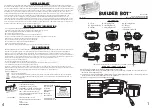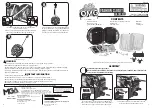
25
I. Quick introduction
Congratulations on purchasing your Eco 7. To enable you to start right away, the following items must be checked off
and the following programming steps must be carried out.
1. On delivery, the transmitter should be set to “Mode 2,” that is, pitch/throttle and the tail rotor on the left-hand
steering unit, the forward pitch and roll function on the right-hand side. If you have the set without a transmitter
or if you wish to modify these settings, read Chapter II, “Channel Assignment.”
2. There is a red and a blue adhesive strip on the decal sheet included that must be glued to the blade tips of the
rotor blades to enable you to set the tracking later on.
3. The rechargeable fl ight battery will be able to develop its full power only after having been charged and dischar
ged several times.
Tip:
For the fi rst 5 times that the fl ight battery is charged, we recommend you discharge the battery by simply
hovering / fl ighing around with the ECO 7.
4. When starting up the helicopter, an operational test must be carried out every time, that is, the swash plate
– viewed from behind – has to move exactly like the control stick of the corresponding operation, that is,
roll right = swash plate sloped to the right, etc. If any functions moving the wrong way, you can reverse the
polarity at the transmitter side with the Reverse switch.
However, this should be performed only with the fl ight battery unplugged.
However, this should be performed only with the fl ight battery unplugged.
5. Affi x the fl ight battery inside the Eco 7 diagonally, using the rubber strap with the holes and pull it over the top
of the battery and secure it to the pin provided for that purpose at the landing gear strut.
6. Turn on the transmitter now and check if the Pitch/throttle function is set to lowest position. Now connect the
fl ight battery to the helicopter.
7. Before takeoff, you should adjust the tail rotor. Proceed as follows: Turn tail rotor function all the way left and
hold until you receive a confi rmation by the tail rotor (tail rotor performs one full rotation). The tail rotor gyro is
adjusted now.
Tip:
If the tail rotor drifts away because of outside infl uences, this procedure can be repeated at any time
(on the ground ONLY).
8. Slowly increase Throttle/Pitch now. The rotor will slowly accelerate to its operational rotary speed due to the
integrated soft startup system. The tail rotor will start up along the fi rst 10% of the control stick path. On delivery,
the gyro is programmed in heading lock mode. It is normal for the tail rotor to start up only once the tail changes
its position on the ground or after takeoff.
9. We recommend that beginners carefully read Chapter III, “Flying with the Eco 7” in order to learn about fl ying
faster and more safely.
10. After fl ying, you should keep in mind that the battery of the helicopter must be unplugged fi rst, and the
transmitter switched off afterwards. The helicopter should always be transported in its case without the battery.
The battery can be stowed away in the cut out section provided for that purpose on the left-hand side of the
styro case (otherwise the fuselage of the ECO 7 may get damaged).





































